Frances Morgan - Sight and Sound
"A stunning new British documentary”
Jasper Sharp - Writer and film curator, Midnight Eye
"A mysterious and compelling meditation on sound, song, story, ritual,
performance, nature, tradition and Japanese Buddhism."
Gaetano Kazuo Maida - Executive Director, Buddhist Film Foundation, Inc.
Review by Vaskar Szen Kayastha for CultHub.com
KanZeOn, although classified as a documentary, should be treated more like an invitation as it divulges into the lives of three Japanese Buddhists, each of whom explore their musical talents and express their philosophy through their instruments. It’s also very difficult to decide how the audience should appreciate this film as you could keep your eyes closed for the entire duration and be treated to an audible sensation like never before. But in doing so, you may miss out on the beautiful cinematography and visual landscape of Kyushu, the third largest island of Japan where it was mainly shot
. It is unusual for a creative medium to be enjoyed in numerous ways and it envelopes into an awe inspiring experience that will almost demand you watch it all over again.
Co-directors Neil Cantwell and Tim Grabham present Akinobu Tatsumi, a young priest who takes care of a temple in Kumamoto City by day and becomes a Dj and beatboxer by night, Eri Fujii, who specialises in a bamboo flute instrument called the Sho that apparently sounds like the mythical bird phoenix, and Akihiro Iitomi, a Noh performer who uses the Kotsudumi Drum in his performances. The film is separated into incantations exploring different episodes of their lives such as their cultural origins, musical duties, discussing the spiritual connection with their instruments and how they perform in front of an audience. The incantations are intersected with scenes and sounds of Japan in all its wonderful glory. Highlights include Tatsumi beatboxing with an amplifier in the middle of a rope bridge that amazingly stretches across a valley and Fujii playing her Sho near a waterfall mimicking it’s flowing tone as if thinking the sounds of the thundering waves and her soft, high pitched notes were in synch. It is often said to understand the artist you must first understand their art and it bears true here for you almost, without cruelty, disregard the musicians explanation and wait patiently for them to perform to understand what they are trying to express through their . They talk of love, passion, dedication, loyalty, faith, spirituality and of course Dharma. In some ways, this isn’t a performance for them. It’s a ritual.
The film does not have a story arc, nor does it have ‘talking head’ segments providing opinions; it focuses instead on evoking emotions that transcend you to another place creating an ambience that is peaceful, spiritual and perfect for meditation. The editing, both visually and audibly, is beautifully crafted allowing you to flow from one incantation to another in tones that seem perfectly pitched throughout. If ever there was an example of a poetry in motion it is KanZeOn, for it beautifully combines different disciplines and elements such as sound, motion, light, history, prayers and chanting, colour, classical, modern, organic and technology as one. Intersected scenes also present other sounds of Japan such as the chimes of ancient temple bells, the murmur among people, the night life from bustling cities as well as the night life from the forest where insects, birds and animal roam.
KanZeOn is a gorgeous film that you’ll certainly enjoy over and over again. What you encounter is a religious experience unlike anything you have felt before as KanZeOn is an alternative spelling for Kannon (Buddhist goddess of compassion) which is written as ‘to see sound’ and that is exactly what this film explores. And it does so exceedingly well.
The journey continues deeper into 2012…
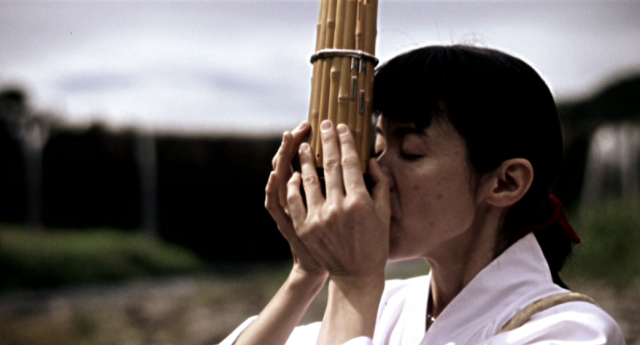
KanZeOn heads North…
As the New Year really gets going so does the continued journey of KanZeOn. This time both Neil and Tim were on the road, starting in Newcastle then on to Edinburgh, with Tim on writing duties for this report…
Our destination in Newcastle was the Star and Shadow cinema
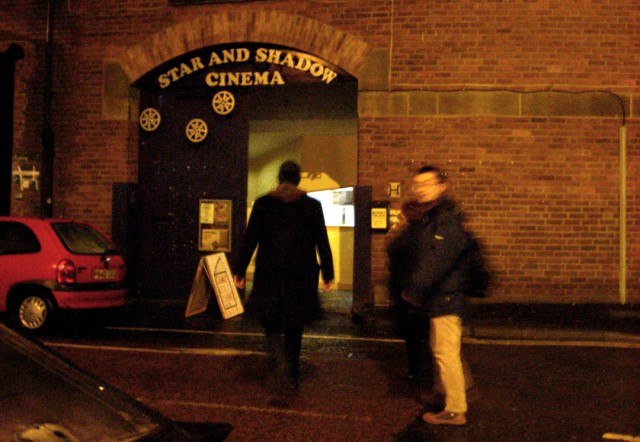
where they were screening 5 programmes of very exclusive Japanese films from Zipangufest – the touring Japanese film festival curated by Jasper Sharp.
We were greeted by the wonderful Stephanie Oswald who took care of us for the duration of our stay and introduced us to the ultra friendly crew at the cinema, which is entirely run by volunteers – from film programming and projecting, to mopping, running the bar, film writing, press work, gig organising and promotion. Jasper had mentioned the cinema as being an amazing location and he was absolutely right.
Our screening was preceded by the dexterous fingers of Carl Heslop on the Compton organ as the audience entered the cinema, which was the perfect atmospheric, and to our delight it was a full house.
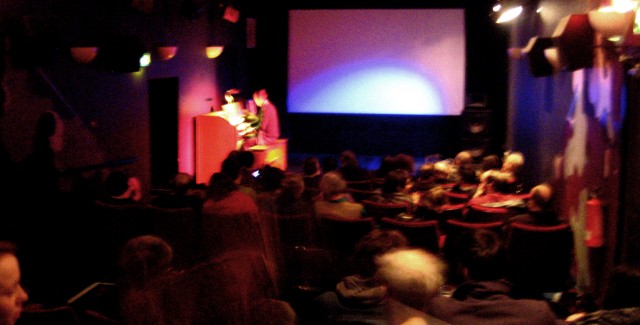
The post screening Q&A was equally rewarding, and this discussion led us out into the bar where we sat for the next few hours chatting with the cinema crew cradling a whiskey or two. Thanks to all of you for making us so welcome.
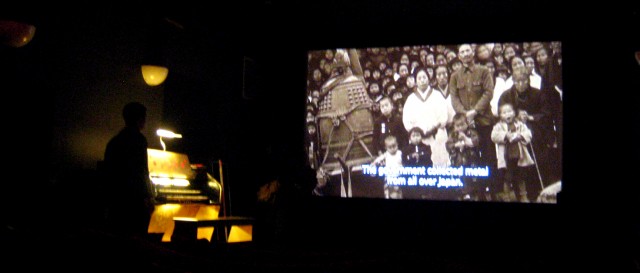
Being such a short trip we were soon on our way to Edinburgh but not before a quick breakfast at the Settledown Café where the cheeriest vibe set us up for the next leg of the trip.
It was to be our second screening in Edinburgh, both of which had been organized by Dr. Ian Astley of the University of Edinburgh. The previous occasion had been as part of Dr. Astley’s ‘Living Buddhism in Retrospect and Prospect’ exhibition
So after a local Haggis and ale lunch we found ourselves in Ian’s cosy study drinking fine green tea and admiring his collection of books.We were again delighted with a great presentation of the film through a lovely clear sound system in the University basement, and another engaged audience who had some really considered questioning for us.Thanks to all who came, especially to Ian for organizing and supporting the film and we look forward to the release of Dr. Astley’s book to accompany the Living Buddhism exhibition, to which we will hopefully be contributing some words on the making and background of KanzeOn.
The trip was too short but we had time for a couple more local ales before making our way to the sleeper train back to London. Both cities and the people we met had revitalized us more than we had expected and it felt like a truly great omen for the films journey into 2012. A knock on the door of the sleeper carriage at 6.20am abruptly pulled us out of deep sleep.
And suddenly we were jettisoned back into central London where everyone seemed to be in a different hectic time dimension to us as they rushed past, shoved us aside and appeared to have gobbled smile extractor pills. Thanks to all the positive people we met and engaged with in Newcastle and Edinburgh who calmed us right down from the London rush.
Tatsumi comes to the UK…
We are finally just about sufficiently recovered to write about the extremely busy timetable of events that occurred about a month ago now, coinciding with the visit to the UK of Tatsumi Akinobu (one of the film’s main characters) and Yuasa Koichi (who has been a supporter of the film from its very inception). Almost as soon as they had arrived we were into a series of radio interviews – one for the Electric Sheep Magazine programme on Resonance FM ‘I’m Ready for My Close-Up’ and then another for the Tokyo Soundscape show on SOAS Student Radio. These appearances were part of promotion for the film’s London premiere, which took place at the ICA on Friday 18th November as the opening night of the Zipangu Fest – we are extremely grateful to Jasper Sharp, Fei Phoon and Tun Shwe and everyone else involved with Zipangu for all of their help and kindness.
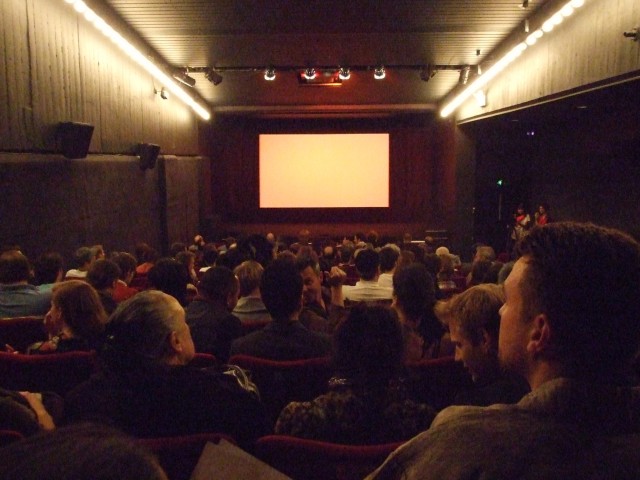
Photo by Koichi Yuasa
Much to our delight the screening was sold out, and we were similarly thrilled to be wearing the kimonos that Tatsumi had brought for us all the way from Japan. We are very grateful to Lucia Dolce from the Centre for the Study of Japanese Religions at SOAS for hosting the Q&A after the film, and to everyone who contributed their questions.
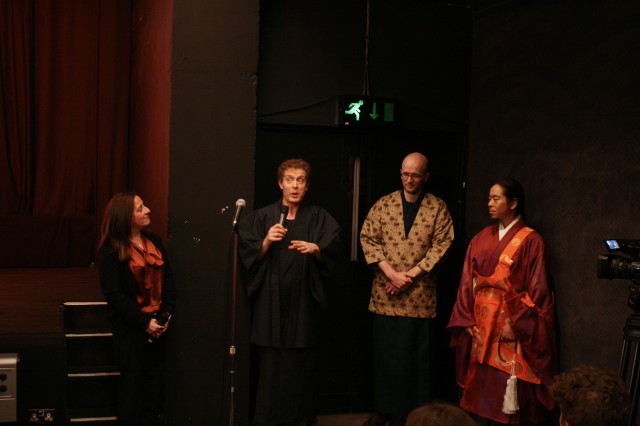
Photo by Fei Phoon for Zipangu Fest
After this it was time for a quick change to get ready for the party afterwards in the ICA bar, for which we are grateful to Paul Fisher, Laurent Fintoni and KidKanevil for providing some wonderful Japanese themed sounds, accompanied by a hyponotic visual remix of the film by amoeba.av – if you’d like to get a little taste of the music that was played, Paul did something of a preview of his set on his Far-Side Radio show, which you can listen to here. Somewhere in the midst of all this we also did an interview for Jon Jung at the VCinema podcast, which you can listen to here.
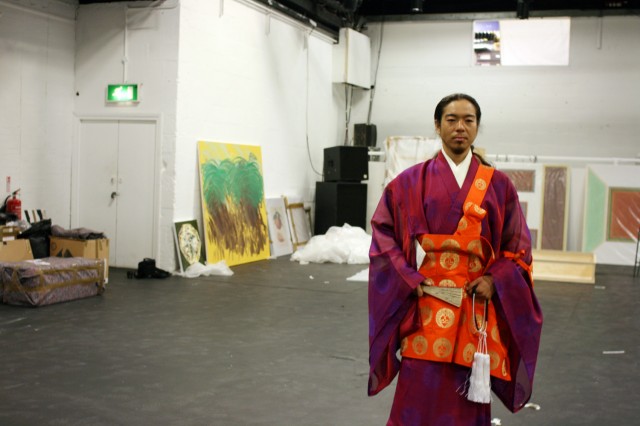
Photo by Fei Phoon for Zipangu Fest
From Priest……to DJ
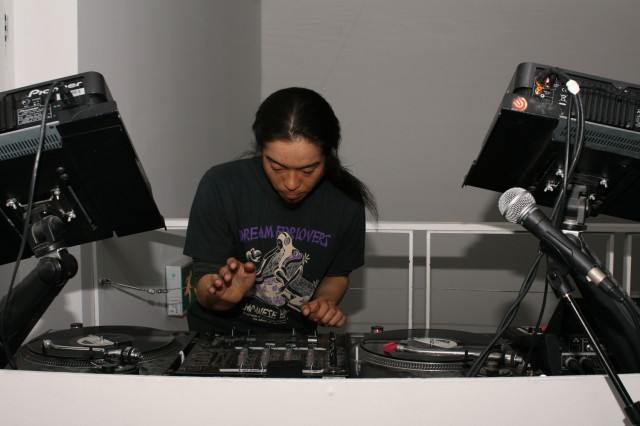
Photo by Fei Phoon for Zipangu Fest
Then the culmination of the night came with impromptu performances on the mic by Tatsumi and Lord Kimo, accompanied by the KanZeOn production crew and friends on percussion.
There was just about time to recover before we were off down to Brighton for a screening as part of the Brighton Cine-City festival – many thanks to Tim Brown and everyone else at the festival. It was a real pleasure to see the film on the big screen alongside people who worked on it, such as Paul Pascoe from Church Road Studios in Hove where we did the sound mix.
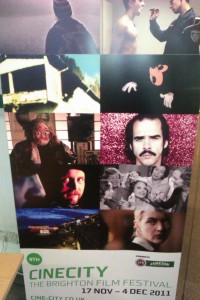
Then the following weekend we were off up to Glasgow for the exciting prospect of a screening in the Inter-faith chapel of Glasgow University – again, our sincere thanks to Yushin Toda and Reverend Stuart MacQuarrie for this amazing opportunity, and to everyone who came and contributed to the discussion after the film. Unsurprisingly the film sounded a bit extra special given the acoustics of such a wonderful building.
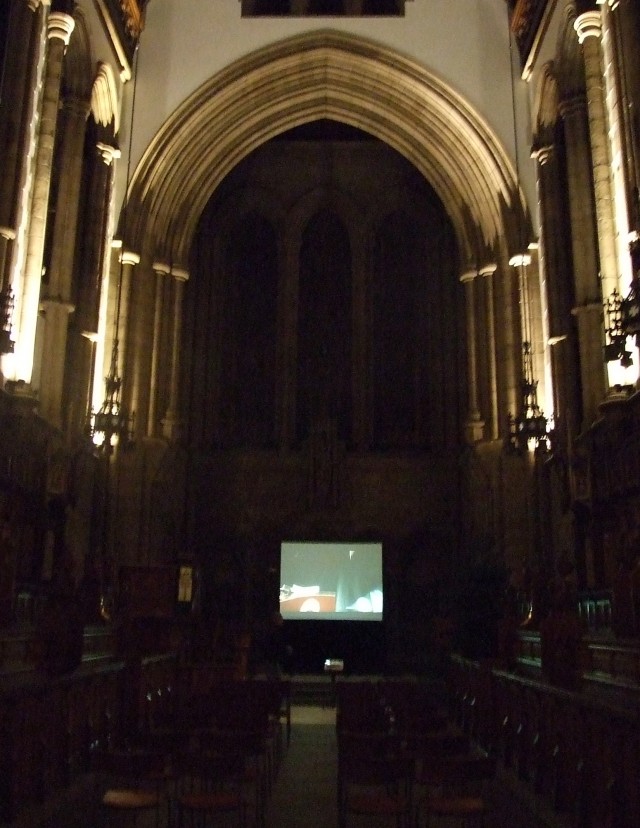
Photo by Koichi Yuasa
Incredibly we were able to attend a St Andrews Day ceilidh straight after the screening, where Tatsumi proceeded to expand the ears of a few of the participants who probably hadn’t encountered the phenomenon of beat-boxing before.
Then the next day we were able to get out of the city for a while to find some of the wilder atmosphere that Scotland has to offer, making it to the end of the adventurous road to Inversnaid before it got dark. And then making it back through the rain and wind in one piece before returning to London…
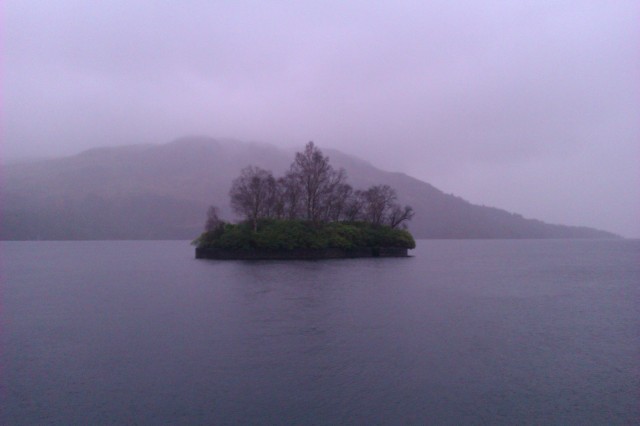
Review by Frances Morgan for Sight and Sound, combined with We Don’t Care About Music Anyway
Worlds of sound: KanZeOn and We Don’t Care About Music Anyway…
Frances Morgan explores two complementary new documentaries about Japanese musicians who foray off the beaten track
In We Don’t Care About Music Anyway…, musicians on the sonic and literal margins of Tokyo scavenge junkyards for sounds, dissect vinyl and videogames, and push instruments and their bodies to the limit as they attempt to express the signal jam of their urban soundscape. It seems a long way from the lush island of Kyushu, where the musicians of KanZeOn practice centuries-old religious and artistic disciplines (with some turntablism thrown in) against a backdrop of wooded hills and moss-covered shrines.
However, there are fascinating commonalities between the two films, both showing at Zipangu Fest, which go beyond an essentialist idea of ‘Japanese’ sound, whatever that might be. In one film, the artists come from improvisational and electronic music traditions, in the other, from a devotional background. These seemingly very different worlds aren’t so dissimilar in their opposition to more conventional ideas of performance, authorship, even what it means to ‘be’ a musician. There is a sense in both camps that music is somehow out of your hands; in these films, this is suggested by a focus on the environments and places that inspire sound, from the deconstructed cello noise of Hirochi Sakamoto in We Don’t Care… to Noh master IItomi Akahiro’s ancient songs in KanZeOn. Unusually for music documentaries, narrative and anecdote are set aside in favour of exploring musical ideas and process.
Perhaps this makes We Don’t Care… rather hard going for some: there is very little explanation of who the film’s subjects are, and the only background information is that which they offer during some informal discussion, which mostly focuses on how and why they make music. Some sense of how, say, older experimentalist Otomo Yoshihide has influenced the younger members of the cast, or how charismatic performance artist Fuyugi Yamakawa developed his blend of sound art, throat-singing and extreme metal might have been interesting, as might something about the ‘scene’ that brought them all together. But maybe we’ve seen too many myth-making music films about scenes – this club, that label, and so on.
Instead, the performance pieces staged by French filmmakers Cédric Dupire and Gaspard Kuentz, which cast the musicians adrift in the city’s detritus, lend the often very abstract music a pleasantly dreamlike narrative. Hirochi Sakamoto is filmed in an abandoned building, dragging the spike of his cello down the resonant corridors and sitting down to play it among discarded office equipment; Yoshihide ‘discovers’ a turntable and customised guitar in a scrapyard where, in the background, a giant claw is crushing a Coca-Cola machine. More conventional gigs are filmed in an intimate, responsive style that recalls another recent French-made and Tokyo-based documentary, Vincent Moon’s portrait of outsider folk artist Kazuki Tomokawa, La Faute de Fleurs.
Place and memory are central to these musicians’ practice. Sakamoto speaks of the city like an ecologist mourning a dying rainforest: soon, he says, there will be “nothing to marvel at”… Tokyo’s buildings “won’t be here forever”. And a similar engagement with surroundings informs the musicians of KanZeOn, especially young Buddhist priest and hip-hop DJ / beatboxer Tatsumi Akinobu, whose beats are inspired by the birdsong around his remote temple.
There’s also sho virtuoso Fujii Eri, who speaks beautifully of her symbiotic relationship with the traditional instrument, a kind of bamboo mouth-organ, but also with an entire world of sound that she is just one part of: “sounds with the same sense of value as an instrument.” Eri’s performances are just some of the mesmerising musical sequences inKanZeOn, which also include excerpts from Noh performances and a Buddhist fire ritual, the sound of which – drums, bells and a crackling wood fire – is elegantly mixed.
The film is drifting and elliptical, arranged into short chapters with little explication, but the extra-musical content means that KanZeOn, while more esoteric in some ways, is probably the more approachable film for the less musically minded. Not only is it stunning to look at, with its waterfalls, temples and traditionally attired performers, but there is some fleshing out of the history, philosophy and belief behind their practice.
There are also traces of classic Japanese cinema, echoes of Kwaidan, for which composer Toru Takemitsu drew heavily on Japanese traditional music and environmental sound. The presence of Akinobu the ‘hip-hop priest’ might seem at first a novelty-ish touch, but it becomes apparent that his sampling the sounds around him is in keeping with Eri’s more spiritual connection with her sound-world: it’s no surprise that co-director Neil Cantwell is himself a musician, and apparently met Akinobu through mutual collaborators.
Eri’s philosophy of sound and music’s equal status, which is echoed in the other traditional musicians’ assertions of music’s integral role in life and ritual, chimes also with the extreme improvisers of We Don’t Care… and their harnessing of the city’s soundscape and technological memories. Of course, the mid-20th century European and American avant-garde that promulgated those ideas was much influenced, John Cage most of all, by Eastern philosophies including Zen Buddhism: influences flow in multiple directions, and neither film tries to pin them down too much.
Near the end of KanZeOn, Akinobu outlines the Japanese concept of ‘ma’, a term that in music means silence or space, yet not in the sense that we understand it as a lack or a gap to be filled. It is a term that has particular resonance in improvisation, in which, as David Toop writes in Haunted Weather, “sounds grow out of silence, but not as significant events enlivening nothingness.” In this short excerpt, Akinobu can only touch upon the very surface of countless theories about what silence is or isn’t. But perhaps, just by being so unusually dedicated to the sonic, both We Don’t Care About Music Anyway… and KanZeOn do in themselves open up a space that will be quite new for some viewers, prompting them to pause and listen afresh to their own soundscapes.
Review by James Mudge at Beyond Hollywood.com
“KanZeOn”, opening the Japanese Zipangu Festival in London on Friday 18th November, is less a documentary and more a spiritual experience. Its title coming from an alternative reading of the Japanese name for the Bodhisattva of Compassion, Kannon, (which literally translates ‘as ‘she who hears the cries of the world’), the film is an exploration of sound and its links with and role in Japanese Buddhism. Directed by Neil Cantwell and Tim Grabham, the British production is indeed hard to pin down or categorise, though in the best possible way, and has enjoyed a successful run at a variety of international festivals.
Shot in and around Kyushu, the 87 minute film is structured as a series of chapters or incantations, and revolves mainly around three fascinating figures and musicians – Akinobu Tatsumi, a young Buddhist priest who takes care of a temple near Kumamoto City and spends his spare time as a rap DJ, Eri Fujii, a woman who has spent her life mastering an ancient Chinese bamboo wind instrument called a sho, and Noh theatre and kotsuzumi drummer Akihiro Iitomi, who also happens to be a huge fan of jazz.
Calling “KanZeOn” a documentary is to a large extent selling it and the ambitions of directors Neil Cantwell and Tim Grabham short. Although on the surface it does follow some of the conventions of the form, being constructed around interviews and featuring footage of its subjects as they go about their daily lives and activities, unlike more traditional documentaries, it never seems to be attempting to teach or to dig into the details of its subject. Instead, it presents itself as an exceptionally evocative affair, which is more about immersing the viewer in sound, and in doing so conveying a sense of shared experience. Through this, despite avoiding the usual kind of explanations and more rigid storytelling often seen in documentaries, the film does a great job of introducing the viewer to the mind set and ideas behind the faith, as well as its sounds.
At the same time, the film is extremely well made, and immaculately knitted together with a wonderful and natural rhythm and sense of flow. All meditative and philosophical aspects aside, it also succeeds on a more basic and cinematic level, with an intriguing method of tackling its rich subject matter that should make it engaging even to viewers with no immediate interest in Japanese Buddhism or traditional performing arts. By focusing on a number of different characters and locations, Cantwell and Grabham keep things moving at a good pace, and the film has enough variety to give an air of objectivity.
The film’s content is in itself worth the price of admission, offering a glimpse at some rarely seen rituals and temples, along with some gorgeous and atmospheric visuals. These range from the grand, encompassing crashing waterfalls, misty mountains and mysterious landscapes, through to the small scale and intimate, depicting raindrops, rustling leaves and insects. All such imagery is tied directly into the associated sounds it creates, helping to further create a captivating and thematically cohesive spiritual portrait. Unsurprisingly, the soundtrack and score, if they can be thought of as such, are simply amazing, and the film is every bit as strong aurally as it is visually, if not more so.
“KanZeOn” really is a unique and enchanting piece of cinema, a lyrical and powerful piece of film making that serves as a reminder of what the form is capable of. Reaching beyond its religious and performing arts subject matter, it emerges as a life enriching experience which lingers and echoes long after the credits have rolled.
Read more by James Mudge at Beyond Hollywood.com here
Three screenings in a week this month…
We’re just bracing ourselves for a very busy time coming up…
As previously mentioned, on November 18th there will be the London premiere screening at the ICA as the opening night of Zipangu Fest, with a large party afterwards to celebrate, featuring music from Ta2mi, KidKanevil, Paul Fisher, Laurent Fintoni and shi_ne_ko_sei, and very special visuals from amoeba.av. We are looking forward to doing a couple of radio shows in the run-up to the event, one for the Electric Sheep Programme on Resonance 104.4FM and then another for Tokyo Soundscape on SOAS Radio – thanks to the hosts for these opportunities and we would also like to express many thanks to everyone working as part of Zipangu Fest for their help and support. We are also very grateful to the Japan Centre for helping to promote the event, and you can win tickets to the screening via a competition on this page on their website.
Then, after a day’s recovery, we will be off down to Brighton on Sunday 20th November to have the pleasure of taking part in the Cine-City Film Festival. The film will be playing as part of the ‘Brighton Screenings’ strand of the festival, given the fact that the film was originally developed while Tim and I happened to meet during the course of living in Brighton – we are very grateful to Tim Brown and all at Cine-City.
And then the following Friday, the 25th November, we will be heading north for a screening in the glorious surroundings of the Glasgow University Interfaith Chapel.
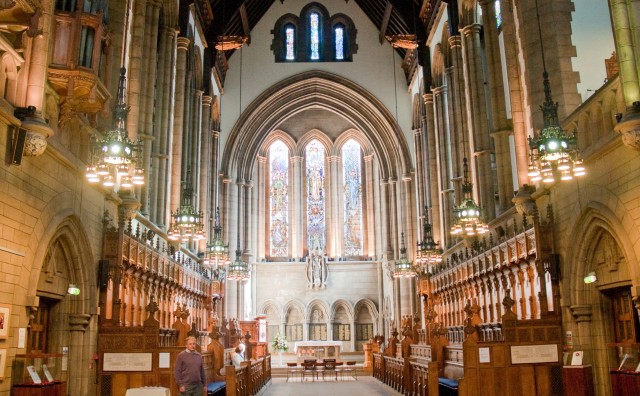
image taken by Phillip Capper, used under a Creative Commons Licence from www.flickr.com
We are very grateful to the Reverend Stuart MacQuarrie and Yushin Toda for this very special opportunity, and are greatly looking forward to seeing how the film will sound in this wonderful space.
Making all of these events even better is the fact that one of the leading characters from the film, Tatsumi Akinobu, will be in attendance, along with Yuasa Koichi (Ko), who played a very special role in inspiring the creation of the film. Ko is my partner in our production duo shi_ne_ko_sei, and his friendship was a hugely significant starting point for making the film, both directly in terms of coming to meet some of the people who came to feature in it, and more obliquely in terms of inspiring interest in the subjects that it deals with.
Tim goes to Warsaw…
The adventures of KanZeOn continued with a very special inclusion in the 27th Warsaw Film Festival this October (http://www.wff.pl/en/ ). As Neil was in the beautiful position of welcoming his newborn son into the world, I again traveled on our behalf, accompanied by the ever supportive Yolanda.
Arriving in the centre of Warsaw we were greeted by the sight of the amazing KINOTEKA (http://www.kinoteka.pl/) in the Palace of Culture and Science, which has to be the grandest venue yet for screening the film.
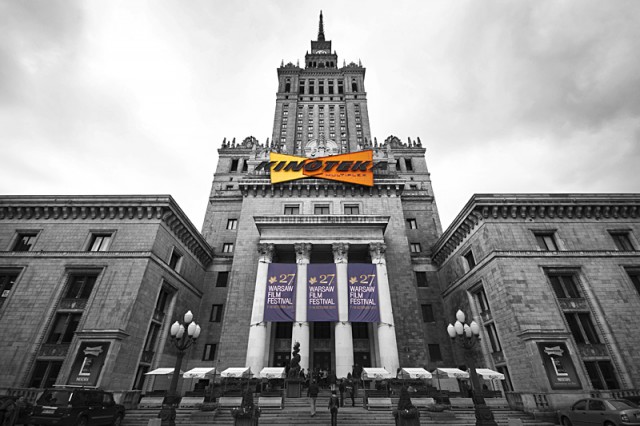
photo courtesy of Alan Kurc
The following day we had a taste of the celebrity atmosphere that surrounded this prestigious festival by being followed around by the super hard working festival film crew, and made our way to the Kinoteka where photographer Alan Kurc (http://aKurc.digart.pl/digarty/ ) was taking portraits of all the guests to the event. Having seen his splendid work on the festival website I was keen to have a go and he took some great shots of us.
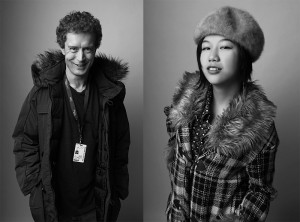
photos courtesy of Alan Kurc
We were playing that Friday night at 6.30 and even though the film had played on two previous days earlier in the week I had no idea how many people had attended, so was genuinely unsure what kind of reception we would have. Amazingly we walked into the cinema and saw it almost full, and by the time the film was ready to start there were none of the 172 seats left and people were sitting on the floor. This was too good to be true and certainly nerve-wracking. But to our great relief everyone stayed to the end and the audience gave a great round of applause.
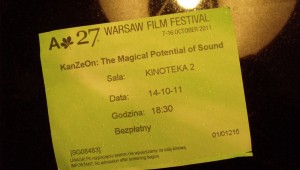
After the screening I nervously gave another Q and A and had some wonderfully thoughtful questions about the nature of distorting time and whether the inclusion of insects in the film was due to Buddhist ideas or our own creative whims. One fine man and world music lover even yodelled to me in the foyer after the screening! This man who introduced himself as Karol Ejgenberg (http://etno.serpent.pl/nowatradycja/2011-foto-karol.php ) runs a blog (http://muzykant.folk.pl/ ) covering all manner of world music and is quite the most energetic and musically mysterious man I have ever met! He later sang to Yolanda in Japanese (we think) and I only hope to meet his splendid self again one day.
On our final day in the city we traveled to the Stare Miasto Old Town which had been totally devastated in 1944 then painstakingly rebuilt in such detail it is hard to believe it was only completed as late as 1962.

It gave a stark reminder that this is a city whose people had endured unimaginable trauma and destruction. Humbling indeed as we returned to the luxury of our 5 star hotel.
That night was the award ceremony and as we were in the documentary competition it was quite exciting to be part of the red carpet event. Of course we did not take any awards away but we did find ourselves quite by chance sitting opposite a certain man called Dennis, who just happened to work with Tom Swindell, our cameraman for KanZeOn! Crazy coincidence especially as Tom had just texted him to mention that the film was playing and we were there too. Indeed we were. Right in front of him!
Thank-you to all at the festival for making it such a great event and for all the great hospitality. And for the lemon vodka. Truly a drink of magick proportions.
London Premiere and Launch Party
We are very proud to be having our London premiere of KanZeOn as part of Zipangu Fest, to be held at the Institute for Contemporary Arts on Friday 18th November. The after party promises to be full of surprises, and as it is the opening of the festival, expect a very lively night! We hope to see you there – click here to book your tickets now.
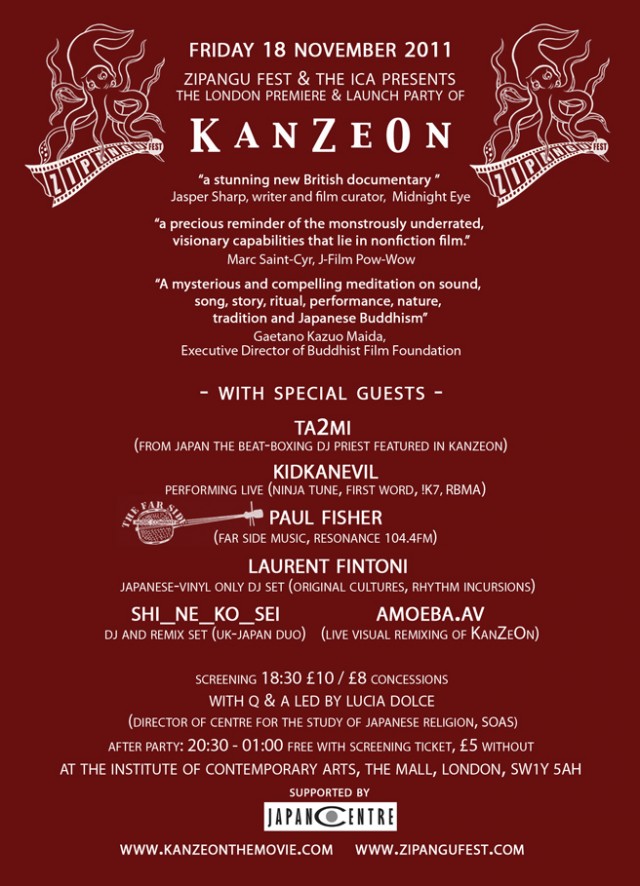
Tim goes to Amsterdam…
It was exciting as ever to attend another screening in the continuing travels of KanZeOn, this time at the Off-Centre festival in Amsterdam.

The Melkweg (www.melkweg.nl) was the venue and we were met nice and early Friday morning by one of the organizers, the super nice Jon Heemsbergen who gave us a tour of this incredible complex. As well as housing two superb rooms for club/gig events there is a cinema, a gallery, a theatre and so much more. It was a true honor to be playing our film there.
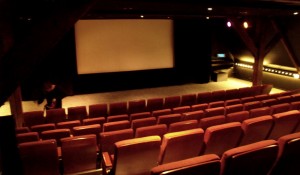
I was already buzzing because I had just noticed this poster outside and couldn’t believe the caliber of films we shared space with. Humbling indeed.
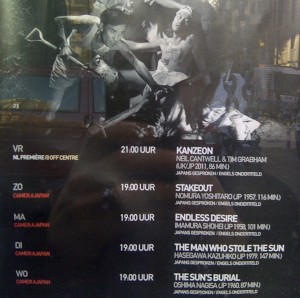
The screening was at 9 so there was plenty of time to get into the Amsterdam mood. It was joyous to then watch an enhanced version of the film and appreciate the incredible acoustics of the cinema but not so helpful when I kept forgetting the questions I was asked afterwards by the audience.
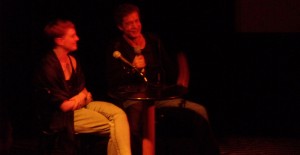
So apologies for my ramblings to those attending! But Radna, who hosted the Q and A, managed very well to keep me mostly on track. And the audience were great and most patient, so thanks again.
The following day continued my using of these trips to the screenings to also spend time making a short film with my lovely partner Yolanda. You just can’t miss out on all these prime locations to add production value to a no-budget movie! The night came again and one of the highlights was Plaid with some of the most pleasing bass heavy tunes I have heard for a while. And later we dropped into the gallery where Harri Pälviranta was showing his exhibition ‘Battered’, dark but bold images of batteries and street violence in Finland. http://www.harripalviranta.com/pages/39

These trips with KanZeOn are giving a great window onto the vibrant creative culture that exists across Europe. In a couple of weeks we go to the 27th Warsaw Film Festival so who knows what surprises will be waiting to stimulate the senses.